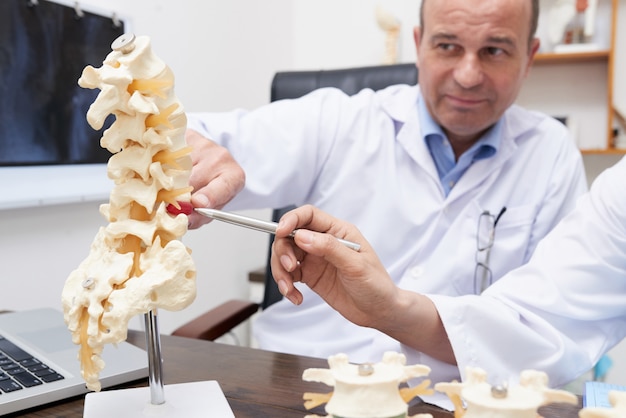Spinal fusion surgery marks the start of a patient’s path to improved mobility and a pain-free life, not its conclusion. Success is ultimately determined by recovery, even though the procedure permanently joins vertebrae to stabilize the spine.
Within two to five days following the procedure, patients may be discharged from the hospital. However, complete recovery? That’s a longer story, usually written over several months rather than weeks. Everything from physical therapy compliance to one’s attitude, diet, and sleep habits influence the journey.
Spinal Fusion Recovery Timeline at a Glance
| Recovery Stage | Time Frame | Key Milestones |
|---|---|---|
| Hospital Stay | 2–5 Days | Walking begins, pain managed with medication, therapy begins |
| Weeks 1–4 | Home Recovery | Walking at home, limited mobility, no driving or bending |
| Weeks 4–6 | Return to Sedentary Work | Resume office work, short walks, reduced brace use |
| 3–6 Months | Bone Fusion Phase | Vertebrae begin to fuse; may return to light physical work |
| 6–12 Months | Strength Recovery | Return to full activities, including lifting and exercise |
| 12–18 Months | Bone Solidification | Bone fusion completes; long-term success evaluated |
Source: Spine-Health
The Biology of the Fusion
Contrary to its name, spinal fusion does not involve the surgical fusion of vertebrae. Instead, between the targeted vertebrae, surgeons insert a bone graft, either from the patient or a donor. The graft is surrounded by new bone over the next few months, which essentially knits the vertebrae into a single, immobile unit.
Titanium screws, rods, or plates may be inserted by surgeons to aid in alignment and encourage healing. In order to maintain proper posture and avoid twisting, some patients wear back braces. These additions represent the body’s adaptability and resilience in addition to being structural.
Walking: The Unexpected Initial Step
Within a day following surgery, the majority of patients are walking, albeit slowly. Early mobilization is medically sound, despite the fact that it may sound ambitious. Mild walking improves circulation, lessens stiffness, and avoids blood clots. Occupational therapists teach new ways to use assistive devices, stand up from a seated position, and get in and out of bed.
Similar to teaching a baby deer to walk again, it is incredibly empowering even though it is shaky at first. You develop the ability to move thoughtfully rather than rashly. For future independence, the initial discomfort becomes a necessary cost.
Why Does the Healing Clock Slow Down?
Recovery can stall or regress; it is not a straight line. The recovery period may be prolonged by conditions such as osteoporosis, obesity, diabetes, nicotine use, malnourishment, and chronic opioid use. Bending, twisting, and lifting are examples of high-risk movements that can cause patients to lag weeks or even months.
The emotional aspect of healing is frequently overlooked by patients. Anxiety and depression can impair immune responses, impair sleep, and reduce motivation for physical therapy. Psychological support is equally as important as medication in these situations.
Moving Past the Brace: Regaining Self-Belief
Back braces serve as both literal and symbolic temporary scaffolds. They serve as a warning sign in addition to supporting the spine. Wearing them makes many patients feel self-conscious, particularly in social or professional settings. But rather than being a sign of weakness, these gadgets are instruments for advancement.
Patients must regain their confidence as they transition from braces to independent motion. One aspect of recovering from spinal fusion surgery that is frequently overlooked is regaining confidence in one’s body. Every little accomplishment, whether it’s lifting a toddler, driving again, or climbing stairs, strengthens the conviction that “I’m healing.”
The Year of Patience: The Last Stage of Fusion
Under the skin, fusion persists in silence even after six months, when some patients are cleared to lift weights or perform heavy labor. It can take up to 18 months for bones to mature. Patients frequently feel normal during this last stretch, but the new vertebral bond still needs to be protected and cared for.
Your surgeon must give the all-clear to resume activities like construction, competitive sports, or rigorous exercise. Many patients, however, find that their new spinal structure works better than they had anticipated. improved posture. Get more rest. Mornings without pain. One vertebra at a time, it’s a silent revolution.
| Aspect | Details |
|---|---|
| Hospital Stay | 2-4 days typically; may be extended based on risk factors. |
| Return to Driving | After 2-3 weeks, only if no longer on opioid medication. |
| Back to Sedentary Job | 4-6 weeks for light office work; 3+ months for physical labor. |
Constant Sacrifices and New Normals
Because spinal fusion prevents motion at the fused segment, the region’s flexibility is permanently diminished. However, for the majority of patients, the trade-off between less pain and more stability makes this change worthwhile. Avoiding high-impact sports, twisting, or carrying unduly heavy loads are examples of long-term restrictions.
However, this is only the beginning of adaptation and does not mark the end of activity. Many people change their lifestyles in ways that feel empowering rather than limiting after surgery by taking up swimming, cycling, or strength training.
The Future of Spinal Healing with Recovery Technology
A more individualized recovery is being shaped by recent developments in bone growth stimulators, surgical robotics, and biomaterials. These days, AI-powered apps monitor patient movement, pain levels, and even sleep patterns, providing doctors with real-time information to improve rehabilitation regimens.
The potential for post-fusion enhancement is expanding as 3D-printed implants and regenerative medicine make their way into clinical trials. In the future, spinal fusion recovery might be more rapid, predictable, and adaptable than previously thought.


